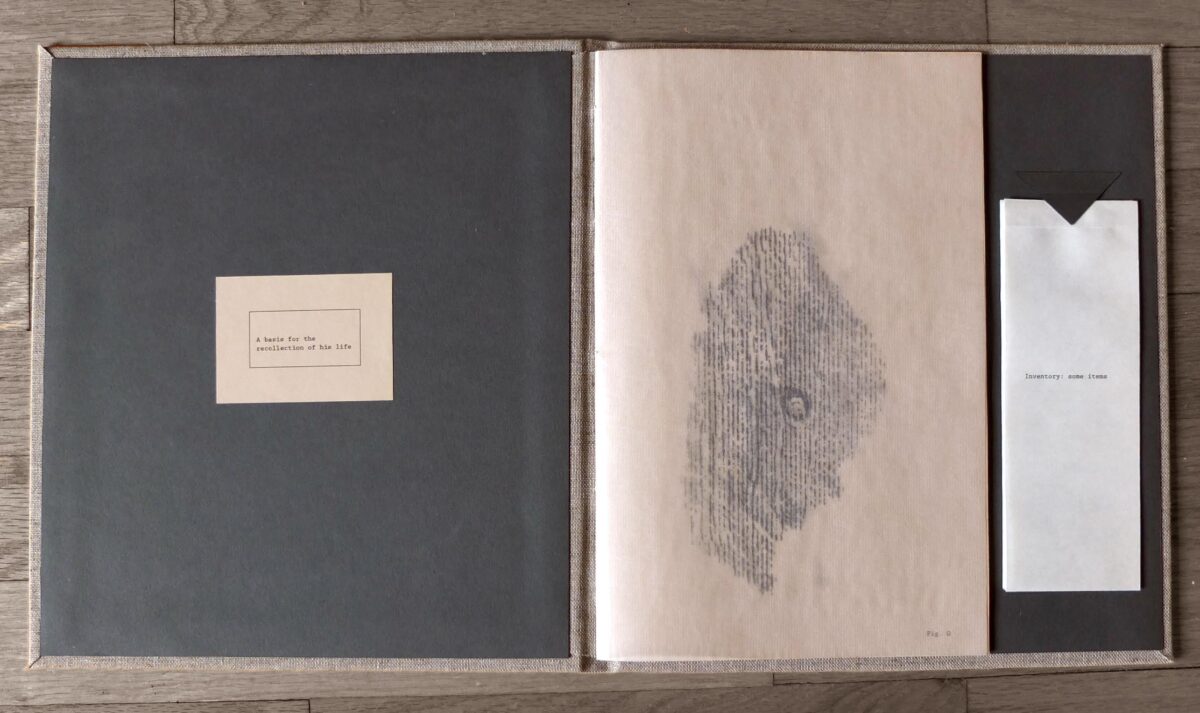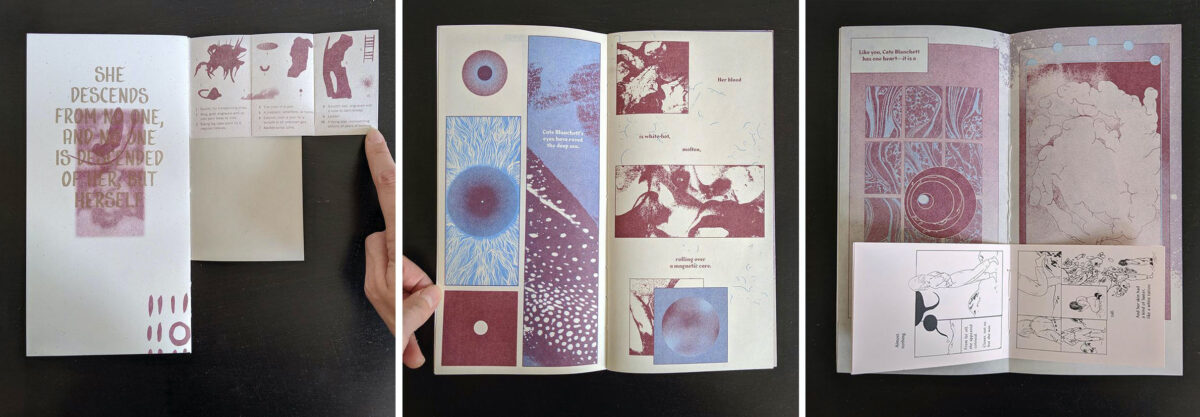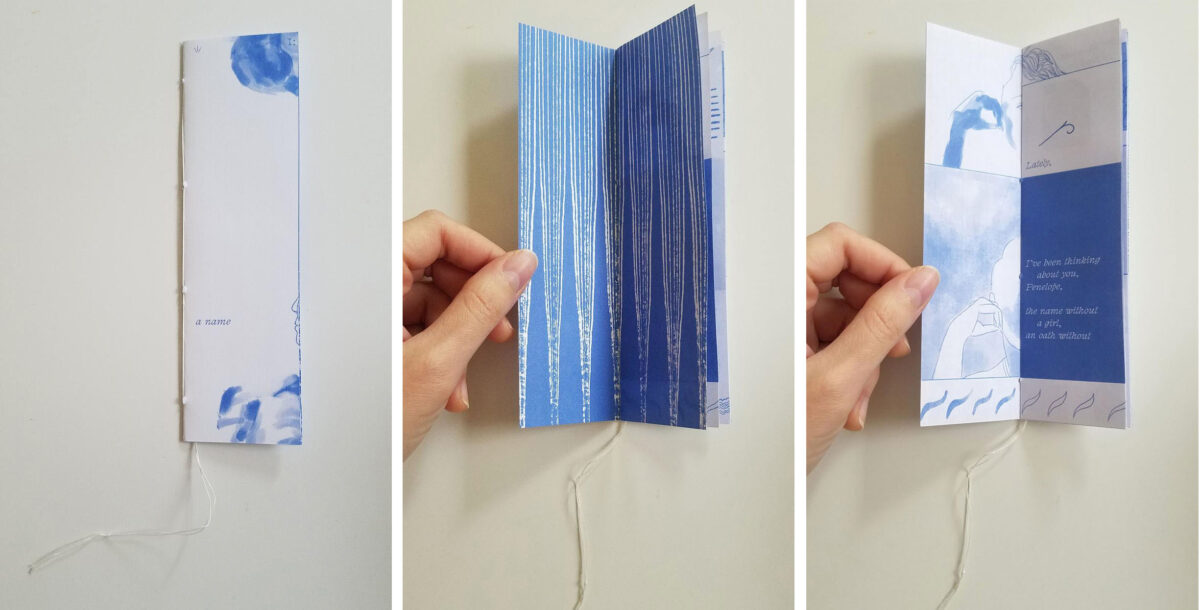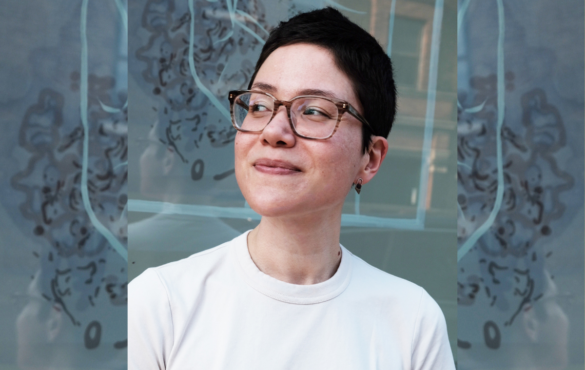Alex Belardo Kostiw is a graphic designer, artist, and educator. Her work deals in poetic and iterative elements, visual structures of comics, and conceptually driven forms. By exploring ambiguities of written and visual language, her publications and prints make space for complex realities of identity and human intimacy. Alex received an MFA in Visual Communication Design from the School of the Art Institute of Chicago and a BA in English literature from the University of Chicago. She lives and works alongside two cats.
Nick Sekits is a multidisciplinary artist who works largely in illustration, printmaking, and multimedia. His work is often influenced by scientific processes, the natural world, and folklore. He graduated in 2020 with a BA in Art and Biology with concentrations in drawing and herpetology.
Nick Sekits (NS): I read that you originally got your bachelor’s degree in English literature. What drew you to print media?
Alex Kostiw (AK): I always loved both books and drawing. For me, they went hand in hand as modes of storytelling–drawing was a way to imagine a story. I went to a college that had a small art department at the time. I loved English Lit, which was my major, and I ended up doing a visual art minor focused on drawing. After graduation, I worked in the art history department. I think that’s when I started to think more about illustration as a way to express a critical understanding of a text rather than as just something ornamental, or as having a one-to-one relationship with what the text already says explicitly. Thinking about that and also working for this department, I became more interested in graphic design and screenprinted posters. And I learned about Spudnik Press, which was not too far from where my partner at the time was living. I signed up for a couple of printmaking classes to refresh my creative practice, and I actually just ended up falling in love with printmaking. And I realized how much I missed learning, so I went to grad school, and that’s how I got to what I do now.
NS: So your journey with print started with Spudnik in a sense?
AK: Yeah, pretty concretely.
NS: What drew you to Spudnik Press?
AK: From what I can remember, there weren’t really a lot of resources like Spudnik Press. And I liked that it was this community space with so much emphasis on different forms of printmaking.
NS: Yeah! I haven’t been there very long, but it does feel very community-oriented. You completed a residency at Spudnik 2016 and are now teaching there, right?
AK: Yeah, I started teaching this past fall, but I have to say, it’s something I was interested in doing for a while. I also wanted to be part of Spudnik again. I haven’t had as much time for my printmaking practice. I figured, if I’m there, I’m going to feel a little more inspired, I’m going to feel a little more connected, and I can also get back into my own work.

Inventory: Recollection | saddle-stitch binding in hard case, accordion fold, laserjet, edition of 1
NS: Do you find yourself returning to literary works or authors as sources of inspiration?
AK: Yeah. One of my favorite authors is Virginia Woolf. I regularly return to Orlando, her sense of humor in that book and the gender play that goes on there […] it’s definitely a novel before its time. I also love her concept that the self is something complicated and that it can be difficult for a person to understand themselves, let alone other people. I’m interested in her work on the kind of unspoken language that happens when two people become truly intimate with each other, or the idiosyncratic language that is unique to them. I also love reading Anne Carson and her poetry, especially her translation of Sappho. The kind of openness there, all of that space where Sappho’s original poetry has disintegrated because it was on papyrus. That stuff didn’t really last, and so we’ve just got these scraps. I think that style definitely influenced some of the writing that I’ve done. And I love comics. It’s hard to choose a favorite in the realm of comics, but I do really like Jia Sung. Jia’s work is fantastic. She’s trained as a painter, but she has also ventured into comics, artist’s books, and poetry.
NS: I have some artists to look into! I also looked at your self-publishing website, tenderly-honestly.com and it made me curious – what does self-publishing mean to you?
AK: There are dynamic definitions of what publishing is. Is it in a digital or physical space? What’s the scale of it? Is it something where the artist has complete control? Is it a collaboration? Are we touching every single book or sending them off to a printer? Self publishing for me means that maybe I work with a printer who is better at using a risograph than I am or who has access to more colors than I do. But for the most part, it’s going through the whole process of writing, drawing, and designing the book for how I want the reader to interact with it, or what space I want to create for the reader to inhabit. I think of the book not just as an object, but as a physical and psychological space. I tend to think about my projects as books, even when they don’t necessarily look like books. They are a kind of narrative sequence meant for a person to move through.
NS: It sounds like self-publishing can mean many things but you prefer to be hands-on with the product you’re making.
AK: I think the other extension of that is I really miss being at art book fairs and comics festivals. I feel like that’s when I get to really connect with people and see them connect with my work. There’s something so rewarding about seeing someone pick up one of my books and go through it, how their face transforms at various moments, or how they’re interacting with the pages. I really miss that.

Enchiridion | 36 pages, saddle-stitch binding and accordion fold, risograph and xerox, 5 x 10.25 inches
NS: I am also interested in sequential art, which I guess is comics in a broad sense. I love how your work dissolves the expectations put forth by traditional comics and really uses them as a narrative device.
AK: Thanks! I honestly feel like in the comics community, especially here in Chicago, a lot of people really push this idea of what a comic is. For that reason, I often think that the only difference between comics and artist’s books is production value.
NS: Right, like what kind of paper is it on.
AK: Exactly. Was it hardbound? Did you sew it by hand? Those are lines that I really just throw away from my work. But yeah, there are a lot of innovative artists here in Chicago, and we’ve got such a great comics community.
NS: On your site, you mention “creativity within constraints.” Could you talk more about what you mean by that?
AK: There are a lot of ways that I think about constraints. I’ll start with this French writing collective called Oulipo. Oulipo is a group of writers and mathematicians interested in discovering new text in existing texts. They felt that all texts that could possibly be generated are already out there. They used algorithmic writing techniques, like composing a new piece out of every fourth word in a found text. Or writing an entire novel written without the letter E. And it’s not just that the letter E is missing from the writing, but it’s a mystery about a character who feels that something is missing and is searching for it.
I found that applying constraints forced me to think about writing as a kind of problem-solving that I had to navigate. Creating limitations gives me a place to start with a project and helps me focus on what the project is really about. It’s a lot like design thinking. In branding, you have a set color palette, a set number of fonts, and different standards for combining them. But within that, there are still endless possible combinations, right? And I think that’s defined how I engage in many aspects of my creative practice. When it comes to screen printing for example, maybe you’re only going to have three screens or two screens to use to make an image. But by reconfiguring or manipulating those couple of stencils, you can make a variety of prints. And when you have constraints as the creator, you also extend those constraints to your audience. You’re only giving them so much. So a lot of my work is also gestural. My work might give very little info to an audience, and it’s up to them to take those gestures of a story and discover what they will in them.
NS: If there is a project that would best introduce your work to people who have not seen your work before, what would it be?
AK: I feel like it should either be the latest thing that I completed or one of the first things that I completed. In grad school, one of the first classes I took is a seminar where I think everyone got into a fugue state at some point, because we were so exhausted trying to pull our projects together. I don’t mean this in a self-congratulatory way at all, but I still look at this piece and think, “Whoa, if I went back, could I do that again?” And I’m not sure I could! The project is called “BOX Actaeon.” It’s a box inside of another box with imagery printed on the outside and inside of each of the boxes. You look through these organically shaped openings throughout and there’s a knob at the bottom to turn the inside box as you’re rotating the outside box. And as you turn it, you can piece together the Greek myth of Actaeon. Actaeon is a hunter who accidentally sees the goddess of the hunt, Artemis, when she’s bathing. She realizes this and turns Actaeon into a stag, and his own hounds tear him apart. Even though it’s one of my first projects, it still encapsulates the interest I have in books as a space that isn’t necessarily what we think of as a book form.

BOX Actaeon | paper object, risograph
The more recent work is a show entitled Pakiramdam that I put together for Co-Prosperity last summer. It is a collection of prints of manipulations of family photos, some on paper and some on fabric. On the windows, there’s also a comic of my mother and I folding a bedsheet, and of a hand trying to grasp at the idea of a seashell, and a couple of short texts. I basically wanted to make a zine, but as an installation project. That piece is really about the ways that people can exist and connect with each other across space and time. My family emigrated from the Philippines, and I was born in Sweden and spent part of my childhood there. I wanted to speak about having a mixed-race identity through these hybrid forms of prints and comics juxtaposed with each other. Since we’re scattered on two continents, it’s pretty normal for my family to interact through screens. But now, the pandemic has made this normal for everyone else–being present in people’s lives, even when we’re physically absent.

Pakiramdam | Installation at Co-Prosperity Sphere (Chicago, IL) digital prints on organza and paper, acrylic paint, vinyl, wood, fishing wire. Documentation by Colectivo Multipolar
NS: What are you working on or what’s getting the gears turning for you at the moment?
AK: I have been doing a lot of teaching. I also have this running series of “bookmark books.” They’re comics that are an outlet for recurring thoughts that are barely even a thought. I am also reworking the text that I originally wrote for my Spudnik residency. It’s been an interesting process because the piece is technically five or six years old. In some ways, I’m the same person I was five years ago, but I’m also a different person. So reworking the piece, I think the characters in it are shifting a bit according to the values and ways of thinking that I’ve developed over the years. There is a kind of comfort in going back to your work and thinking, “This is worth seeing through and giving it a second life.” The other project that I really want to get to is turning “Pakiramdam” into a zine. I did a lot of research into material culture of the Philippines that didn’t come through explicitly in the show, so I’m working on putting that together.

book/mark: A Name | 12 pages, saddle-stitch binding, risograph printed, 2 x 7 inches
NS: Between teaching, editing, and ongoing work on personal projects, it sounds like you’re juggling a lot at once.
AK: Yeah. I think one thing I’ve learned is that sometimes, I feel a pressure to be productive, like I’m not working fast enough. But there’s no “too fast” or “too slow.” If I feel like I’m doing what I can do right now and I’m happy with what I’m doing, it’s fine. It’s enough.
NS: Something that I feel plagues many artists is the feeling of not producing enough, fast enough. But it really is okay. Some ideas are slow ideas and that’s just how they ought to be. Where’s the best place for people to kind of get in touch with you or find your work right now?
AK: I am @meanwhile_alex on Instagram, but I take long breaks from social media. I also try to update my websites (tenderly-honestly.com and alexkostiw.com) every once in a while with new projects.
